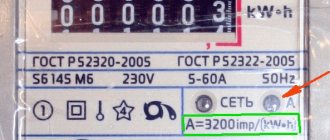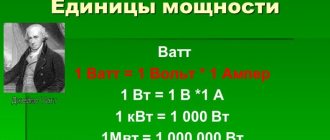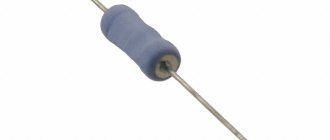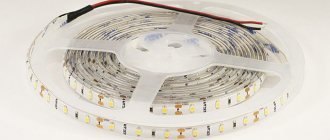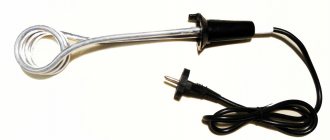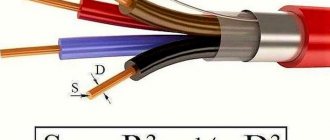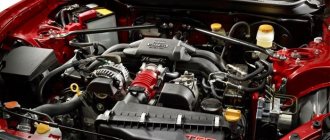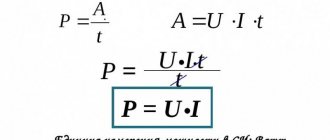What is power consumption?
Power consumption is a numerical measure of the amount of electrical energy required for the operation of an electrical appliance or converted by it during operation. For static devices (stove, iron, TV, lighting), current energy turns into heat during operation). During conversion (electric motors), the energy of electric current is converted into mechanical energy.
The basic unit of electrical power is Watt, its numerical value
P = U × I,
where U is voltage, Volts, I is current, amperes.
Sometimes this parameter is indicated in V×A (V×A for imported equipment), which is more correct for alternating current. The difference between Watts and VA for household networks is small and can be ignored.
Electrical power consumption is important when planning wiring (the cross-section of the wires depends on it, as well as the choice of ratings and the number of circuit breakers). During operation, it determines the costs of maintaining the home.
Power tables for heating electrical appliances
Electric heating devices are used as the main and additional heating of rooms. The low cost of equipment, high mobility and the ability to use without installation work have made these devices very popular.
It should be remembered that the power of electric heating devices is quite high, and when using them, wiring and automation should be used that can withstand this load.
The most popular electric heating devices are:
- electric thermal fans;
- electric heating radiators;
- electric heating convectors.
Below are power tables for household electric heating appliances.
Thermal fan power table
| № | Device name | Electrical power of the device |
| 1 | Fan heater Zanussi ZFH/C-410 | 1,500 W |
| 2 | Fan heater VITEK VT-1759 SR | 1,500 W |
| 3 | Ceramic fan heater Scarlett SC-1051 | 1,800 W |
| 4 | Ceramic fan heater Electrolux EFH/F-8720 | 2,000 W |
| 5 | Fan heater De Longhi HVA3220 | 2,000 W |
Power table for oil radiators
| № | Device name | Electrical power of the device |
| 1 | Radiator De Longhi TRD4 1025 | 2,500 W |
| 2 | Radiator Polaris PRE L 0715 | 1,500 W |
| 3 | Radiator Electrolux EOH/M-6209 | 2,000 W |
| 4 | Radiator Supra ORS-07-MN | 1,500 W |
| 5 | Radiator Sinbo SFH 3322 | 2,000 W |
Heating convector power table
| № | Device name | Electrical power of the device |
| 1 | Convector Electrolux Brilliant ECH/B-2000 E | 2,000 W |
| 2 | Convector De Longhi HSX3320FTS | 2,000 W |
| 3 | Convector Ballu Camino Eco BEC/EM-1000 | 1,000 W |
| 4 | Convector Scarlett SC – CH832/1500 | 1,500 W |
| 5 | Convector Supra ECS-520SP | 2,000 W |
The problem of proper operation of the household electrical network
From a constructive point of view, the household electrical network has been developed to a high degree of perfection: its normal operation does not require special knowledge.
The network is designed for certain operating conditions, the violation of which leads to complete or partial failure, and in severe cases, to a fire.
The condition for proper operation is the absence of overload.
At the same time, the load capacity of sockets and the consumption of equipment connected to them are measured in different units:
- for sockets this is the maximum permissible alternating current (6 A for traditional Soviet sockets of old housing stock, 10 or even 16 A for European-style sockets);
- connected equipment is characterized by power, which is measured in Watts (for powerful devices, larger units are indicated instead of Watts: kilowatts (1 kW = 1000 W), which allows you to avoid confusion with numerous zeros).
Hence the need arises:
- determining the relationship between power and current;
- finding the power of an individual electrical appliance.
The relationship between Watts and Amps is simple and follows directly from the definition of Watt above. The task is simplified by the fact that the voltage of a working household network is always the same (220 or 230 V). From here, power is always found along the current.
Electric water heater power tables
Electric household water heaters of various types are widespread in our country. This is a convenient way to heat water in homes where there is no central hot water supply. Electric heaters are also often used during repair work in hot water supply networks.
The most popular household electric water heaters are:
- electric storage water heaters;
- electric instantaneous water heaters.
It should be remembered that the power of electric water heaters of various types is quite large, and when using them, wiring and automation should be used that can withstand this load.
Table of power of storage water heaters
| № | Device name | Electrical power of the device |
| 1 | Storage water heater Haier ES50V-F1 | 3,000 W |
| 2 | Storage water heater Electrolux EWH 80 | 2,000 W |
| 3 | Storage water heater Thermex ID 80 V | 2,000 W |
| 4 | Storage water heater Ariston PRO R 100 V | 1,500 W |
| 5 | Storage water heater Polaris OMEGA 30V | 2,000 W |
Table of power of instantaneous water heaters
| № | Device name | Electrical power of the device |
| 1 | Instantaneous water heater Atmor Basic 5 kW | 5,000 W |
| 2 | Instantaneous water heater Atmor Basic 3.5 kW | 3,500 W |
| 3 | Instantaneous water heater Electrolux SMARTFIX 2.0 T | 3,500 W |
| 4 | Instantaneous water heater Electrolux SMARTFIX 2.0 | 5,500 W |
How to determine?
To solve the problem of finding power, you can use various methods. All of them are available for use even with knowledge of physics and electrical engineering at the school curriculum level.
More often, power is found by determining the current; sometimes you can do without intermediate procedures and determine it immediately.
We look at the technical passport
Typically, the power consumption is indicated in the passport or description of the device and is duplicated on the nameplate. The latter is located on the rear wall of the case or its base.
If there is no description, this parameter can be found on the Internet, for which you just need to search by the name of the device.
The power indicated by the equipment manufacturer refers to peak power and is consumed from the network only at full load, which is quite rare. The resulting difference is considered as a reserve. At the regulatory level, this reserve is determined through the power factor.
Ohm's law to help
The power of most household electrical devices can be fairly accurately estimated experimentally and by calculation using Ohm's law, known since high school. This empirical law relates voltage, current and load resistance R as:
P = U2/R. U = 230 V, and the resistance is measured by a tester. The following is a simple calculation using the formula P = 48,400/R W.
For example, with R = 200 Ohm we obtain power P = 240 W.
The method does not take into account the so-called reactance of the device, which is created primarily by input transformers and chokes, and therefore the resulting estimate is somewhat overestimated.
We use an electric meter
When determining power from a meter, you can proceed in two different ways. In both cases, only the device under test should be powered from the household network. Without exception, all other consumers must be disconnected.
In the first approach, an optical meter indicator is used to measure power, the intensity of its flashes is proportional to the power consumption. The proportionality coefficient is indicated on the front panel in units imp/kWh or imp/kWh, Figure 1, where imp is the number of pulses (indicator flashes) per kilowatt hour.
Figure 1. Front panel of a household electricity meter with optical indicator
After turning on the device under test, you must begin counting the indicator flashes for 15 or 20 minutes. The resulting value is then multiplied by 3 or 4 (for a 20- or 15-minute measurement interval, respectively) and divided by the coefficient from the front panel. The result of the calculation gives the power of the device in kW, which in some cases is conveniently converted into Watts by multiplying by 1000.
Example. For the counter we have k = 1600 pulses per kilowatt hour. With a 20-minute measurement interval, the indicator worked (flashed) 160 times. Then the power of the device will be 160*3/1600 = 0.3 kW or 300 W.
The second approach also uses a 15- or 20-minute time interval, but the energy consumption is determined on a digital scale. For example, with a difference in readings over 20 minutes of 0.2 kW×hour, the power of the unit is 0.2 × 3 = 0.6 kW or 600 W.
Wattmeter
A modern household power meter or wattmeter is convenient to use because:
- it is connected directly to the open circuit, for which it is equipped with a plug and socket, see Figure 2;
- equipped with an easy-to-read digital indicator and equipped with internal automatic adjustment circuits, which eliminates errors in readings;
- has good weight and size characteristics.
The device is ready for use immediately after switching on.
Rice. 2. Digital household wattmeter
Its only drawback is its narrow specialization, so this device is rarely found in the household.
Air conditioning equipment power tables
Modern split systems are now installed in many homes. When choosing wiring and automation for powering split systems, you should remember that to calculate the total power of such devices, the reactive component should be taken into account. Large starting currents at the moment of starting the compressor significantly increase the maximum value of the total power of the device. For a simple calculation of total power, you can use the magnifying factor “4”.
It should be remembered that the power of split systems is quite large, and to supply them with power it is necessary to use wiring and automation that can withstand this load.
Modern split systems are quite sensitive to the voltage in the power supply network. If the voltage is low, the appliance may not work or may not operate efficiently. Low and high voltage significantly reduce the service life of climate control equipment. In such cases, voltage stabilizers with the ability to handle high inrush currents should be used.
Split system power table
| № | Device name | Electrical power of the device |
| 1 | Split system Samsung AR07HQFSAWK | 640 W |
| 2 | Split system Haier HSU-09HMC203/R2 | 880 W |
| 3 | Split system Electrolux EACS-09HAR/N3 | 840 W |
| 4 | Split system Supra US410-09HB | 1,000 W |
| 5 | Split system LG G18NHT | 2,400 W |
Power table for floor standing air conditioners
| № | Device name | Electrical power of the device |
| 1 | Mobile air conditioner Zanussi ZACM-09 MP/N1 | 1,050 W |
| 2 | Mobile air conditioner Electrolux EACM-10 DR/N3 | 900 W |
| 3 | Mobile air conditioner Bimatek AM400 | 1,000 W |
| 4 | Mobile air conditioner Ballu BPAM-09H | 1 100 W |
| 5 | Mobile air conditioner De Longhi PAC WE126 | 1 100 W |
Direct current measurement
The methods of that group are characterized by higher accuracy due to the fact that they are based on direct measurement of current. There are two devices for performing this procedure at home.
Metering with current clamps
The most convenient to use are current clamps that do not require breaking the controlled circuit. Designed as a hand-held device with a measuring unit based on a toroidal core. To measure the current, the assembly is opened in the manner of pincer sponges, and then closed to cover the wire, Figure 3. The effective value of the current is determined by the change in the magnetic field, which is recorded by the Hall sensor.
Rice. 3. Measurement with current clamps
Measurement with a tester
The second method is based on the use of a tester, which is switched to ammeter mode and connected to an open circuit. The difficulties of implementing this procedure using simple means make it little popular in practice. We also cannot discount the fact that some tester models do not have current protection and fail (burn out) if the range is incorrectly selected (current overload).
How to find a phase in an outlet, and why three-phase ones are needed; how to measure voltage and determine current
Often, when making any changes to the electrical wiring, it becomes necessary to determine the phase wire. Regardless of the voltage in the outlet, according to modern standards they must be color-coded. So the yellow-green wire is ground, and the blue or cyan wire is zero. Accordingly, the rest (one or three) are a phase; usually phase wires are:
- according to standards before 2011 – yellow, green, red;
- after 2011 – brown, black, gray.
However, in some networks installed before 2011, the black wire was used for grounding. In addition, in single-phase wiring it is customary to connect the phase on the right.
If any markings are missing, then a probe with a neon lamp will be useful. When you touch a phase, the indicator will light up. If a probe with an LED is used, do not touch the metal pad at the end of the handle with your hand when testing. To determine how much current is in the outlet, you need a voltmeter. It is also useful in determining the phases of a three-phase connection. So between each phase and zero there will be 220V at a linear voltage of 380V and 127V at a linear voltage of 220V (but the latter connector is practically never found or used today). In household networks, a three-phase connection can be used for kitchen stoves with high-power electric ovens. Terminal boards in some models thus allow the load to be evenly distributed.
Built-in kitchen
Services for the production of kitchen furniture sets for specific dimensions and configuration of the kitchen have been offered by furniture manufacturers for decades. As a result of the improvement of this service, the concept of a built-in kitchen appeared - a set of household electrical appliances compactly built into a set of kitchen furniture.
Built-in kitchens are produced both standard, taking into account only the dimensions of the room, and according to individual orders - taking into account the location of window and door openings, pipelines, etc. in the room. The second option of built-in kitchens is used for arranging small spaces.
The popularity of fitted kitchens is high and continues to grow for the following reasons:
- maintenance of furniture-mounted units is simplified, as they are less susceptible to contamination and mechanical damage;
- installing household appliances in a furniture set deprives the room of its resemblance to a production facility and adds coziness to it.
Built-in kitchens also have disadvantages:
- high price, which includes installation of equipment into furniture;
- limited availability for routine maintenance and repairs;
- complexity, and more often - the impossibility of rearranging devices in the headset (only replacement with units with identical characteristics).
